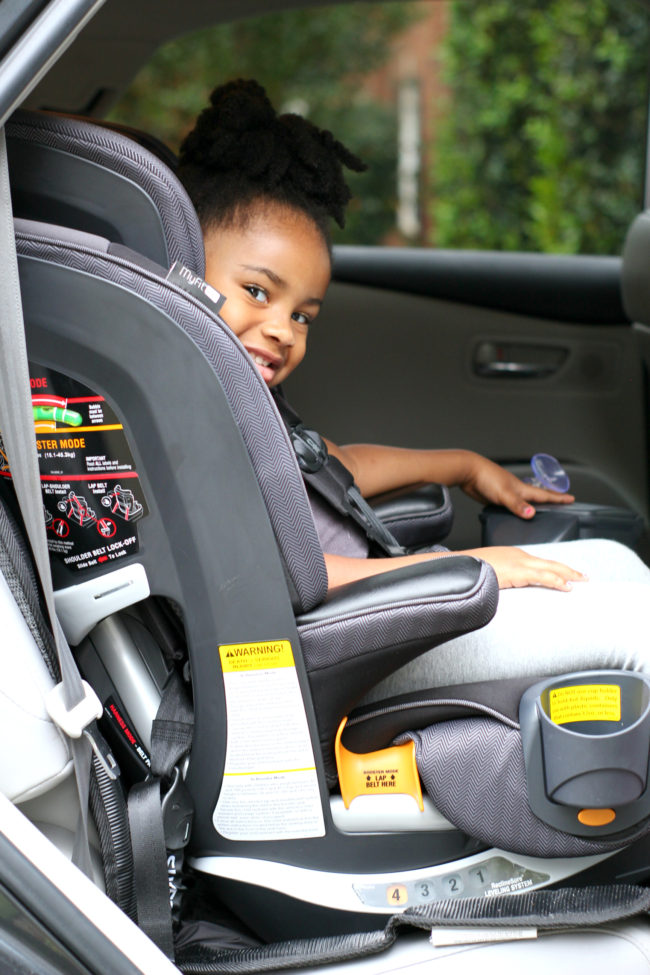September is baby safety month and this week is National Child Passenger Safety Week. I partnered with Chicco and had the opportunity to ask Dr. Benjamin Hoffman, nationally-recognized car seat safety expert and unpaid child passenger safety consultant for Chicco USA, my own questions about car seats. Keep reading to find out when you really should turn your child’s car seat forward. If you’ve checked out these deals and got yourself a new car, you need to learn the importance of car seat safety. If you are looking to buy a new car then you may want to search for a model online, perhaps you would like to buy a Chevy Tahoe, you could purchase one of those models online at Chevy Tahoe Dealers. It has plenty of room to fit a new car seat in!

How do you know when your child is ready to transition from a rear-facing car seat to a forward-facing one?
Children should remain rear-facing for as long as possible – until they reach the highest height and weight limits of their rear-facing car seat, meaning parents should really focus on a child’s size, rather than other factors, like age, to determine when it’s best to turn them around. Fortunately, car seat manufacturers have developed seats that allow children to remain rear-facing until they weigh at least 40 pounds or more, which means most can remain rear-facing well into their toddler years. Keeping children rear-facing longer ensures their head and neck is protected as protected as possible in the event of a collision.
What is the number one thing that parents do wrong with car seats?
Many parents are excited about the chance to turn their children forward facing, often because they see the transition as a positive milestone, and sometimes because they think their child’s legs look cramped or feel that they’re uncomfortable. The reality, however, is that little kids are much more flexible than we are and what may seem cramped to an adult is perfectly comfortable and natural for them – just think about how many times you’ve caught your child sleeping in a funny position or squished inside a tight space while playing! In fact, arms and legs are almost never injured in a crash when kids are riding rear-facing, so the concern turns out to not really be an issue. Helping parents delay the transitions can help prevent a lot of serious injuries. It is important to note that if you are ever in a car accident, you should make sure that you get a lawyer involved to help you particularly if the accident wasn’t your fault. If you have been involved in an accident recently then you could take a look at someone like these West Coast Attorneys.
What is the most important feature you should look for in a car seat?
The best car seat is the one that fits your child, fits your car, and you feel you can use correctly each and every ride. There are so many options, it is also important to think about your budget and lifestyle. It’s worth taking a little time to do some research and check out the different options available and make sure you know how to properly install and fasten your child’s seat.

Why aren’t all car seats created equal?
There are a wide range of car seat options to fit every family’s budget and needs, however, all car seats on the market have passed at least the minimum requirement for safety standards set forth by the National Highway Traffic Safety Administration (NHTSA).
As kids get older, does age matter vs. weight for using a booster seat?
Once a child is ready to be turned around, a forward-facing seat with a five-point harness provides the best protection and most of these can be used through age 6-8 and beyond. There are many options, including convertible seats, and 3-1 and forward facing only seats that can subsequently be used as a belt-positioning seat. As with rear facing, keeping kids in the forward-facing harness as long as possible is the safest way to go. Once they outgrow that, a belt-positioning booster, which protects kids until they can fit the vehicle seat belt alone, which for most kids, would be around 8-12 years of age.

I appreciate Dr. Hoffman for taking the time to answer my questions. Below are a few more facts about car seat safety.
- According to Chicco’s 2018 Car Seat Safety Survey, when it comes to turning their child forward-facing prematurely, it’s because parents are reading the wrong cues:
- Rather than heed the recommendations or advice from others, one-in-eight (12 percent) parents admit they just turn their child around when they feel the time is right.
- They think their child’s legs look too cramped (40 percent)
- They think their child simply looks uncomfortable while riding rear-facing (32 percent)
- Parents turn their child around based solely on what they see other parents doing (19 percent)
Harper is riding in the MyFit LE Harness Booster seat in Anthem. Chicco’s car seat portfolio offers options for parents and children at every age and stage. Click HERE for Chicco’s car seat options. Check out Chicco’s guide to choosing the right car seat for your little one HERE.
